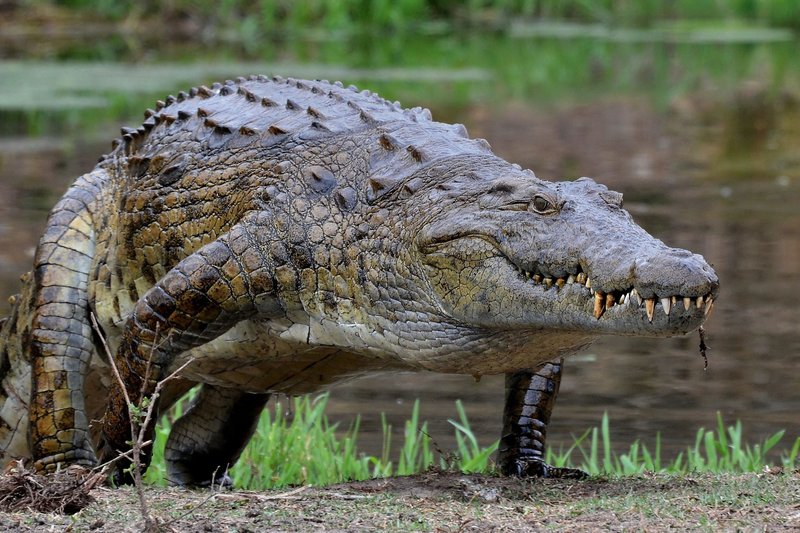
You might be wondering why we often find ourselves misinformed about these majestic reptiles. It’s easy to get lost in sensational stories or half-truths. Thankfully, by unpacking these myths, we can appreciate the Nile crocodile for what it truly is—a vital player in its ecosystem, with a fascinating life cycle and behavior. So, let’s explore some common myths and facts about these remarkable creatures.
Myth 1: Nile Crocodiles Are Always Aggressive
One of the most common beliefs about Nile crocodiles is that they are aggressive creatures, attacking anything that moves. While it’s true they can be dangerous, particularly when provoked, Nile crocodiles are not mindless killers. They tend to be cautious and prefer to avoid confrontations when possible.
Here’s the thing: crocodiles have a specific diet, primarily consisting of fish, birds, and small mammals. They hunt using stealth, waiting patiently for the perfect opportunity. So, while they can attack when feeling threatened or cornered, most interactions with humans that lead to attacks are due to human error—like getting too close to their nests or territories. Understanding their behavior can significantly reduce dangerous encounters.
Interestingly, Nile crocodiles can exhibit a range of social behaviors. They communicate with each other through vocalizations and body language. Unlike the stereotype of a lone, ferocious beast, crocodiles can be social when it comes to basking in the sun or resting in the water.
Myth 2: They Can’t Regulate Their Body Temperature
Another myth is that Nile crocodiles are unable to regulate their body temperature. This belief likely stems from the fact that they are cold-blooded reptiles. However, this doesn’t mean they are at the mercy of external temperatures.
Cold-blooded creatures, like the Nile crocodile, can adjust their behavior to regulate their body temperature. For example, they bask in the sun to warm up or move into the shade or water to cool down. This ability is crucial for their survival, especially in the fluctuating temperatures of Africa’s rivers and lakes.
Not only do they skillfully manage their body heat, but they also have an incredible tolerance for various environmental conditions. Their bodies are designed to thrive in different habitats, from rushing waters to slow-moving streams. They adapt remarkably well, demonstrating impressive resilience.
Myth 3: Nile Crocodiles Are Purely Aquatic Creatures
You might think Nile crocodiles are only found in the water, but that’s not entirely accurate. Yes, they are excellent swimmers and do spend a huge amount of time in rivers, swamps, and lakes, but they also venture onto land.
They may not be the fastest on land, but Nile crocodiles are certainly capable of moving quickly over short distances. When basking, they often come onto the shore to soak up some sun. This behavior is essential for thermoregulation, which we discussed earlier, and helps them stay active.
In addition, Nile crocodiles will sometimes travel long distances on land to find new habitats. They have been known to cover several kilometers in search of food or a suitable place to lay their eggs. This adaptability is one of the reasons they have thrived in various environments.
Myth 4: They’re Not Intelligent Creatures
Another misconception is that crocodiles, including the Nile crocodile, lack intelligence. In reality, these reptiles are quite smart, particularly in their hunting strategies. They have been observed using tools, such as sticks, to lure birds during nesting season. This demonstrates a level of problem-solving ability that many people wouldn’t associate with reptiles.
Remember that a crocodile’s success as a predator relies heavily on its ability to learn from its environment. They can recognize their surroundings and even remember the positions of prey. Some studies suggest that they may even exhibit some form of social learning, where they can observe and mimic the behavior of other crocodiles.
This brings us to the interesting fact that Nile crocodiles have a form of communication. They use distinct sounds to express different needs, whether it’s a warning call to alert others or sounds to attract mates. This level of social interaction shows their intelligence and adaptability.
Myth 5: Nile Crocodiles Are Endangered
You might be surprised to learn that, while many crocodile species are endangered, Nile crocodiles overall are not considered endangered. They are classified as “Least Concern” by the International Union for Conservation of Nature (IUCN). Their populations are stable, thanks partly to successful conservation efforts in various regions.
That said, local populations can still be threatened by habitat loss, hunting, and pollution. In some countries, Nile crocodiles are hunted for their skins and meat, which can negatively impact specific populations. It’s crucial to monitor these practices and promote sustainable approaches to ensure their long-term survival.
Organizations around the world are working to protect these reptiles. Many efforts focus on habitat conservation and educating the public about the ecological importance of Nile crocodiles. By understanding their role in the ecosystem, we can better appreciate these creatures and help ensure their continued presence on our planet.
As we’ve explored, there are plenty of myths surrounding the Nile crocodile that can lead us to misunderstand this incredible creature. By debunking these misconceptions, we can appreciate the real nature of Nile crocodiles—complex, intelligent beings that play a critical role in their ecosystems.
Honestly, the next time you hear a story about these reptiles, ask yourself: is it based on fact or fiction? Separating myth from reality not only enhances our understanding of crocodiles but also helps us coexist more peacefully with wildlife. So let’s celebrate the Nile crocodile for what it truly is: a powerful, adaptive creature that deserves our respect and protection as stewards of the natural world.

